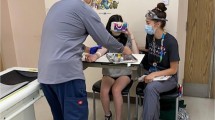Abstract
Background
MRI in small children generally necessitates the use of general anesthesia.
Objective
We describe our initial results with a new technique that we name the feed-and-sleep method, whereby an infant can undergo a cardiac MRI without the need for general anesthesia or sedation.
Materials and methods
The infant is fasted for 4 h prior to the scan and is then fed by his mother prior to the scan. He is then swaddled with 1 to 2 infant sheets before being placed in a vacuum-bag immobilizer. As air is removed from the bag, the immobilizer becomes a rigid cradle that fits the infant’s body. We prioritize the sequences according to the purpose of the study and in the order of clinical importance.
Results
Between January 2010 and January 2011 a total of 20 infants with the median age 14.5 days (minimum 2 days, maximum 155 days) underwent CMR studies via this method. All were performed successfully with no distress to the infant. The median scan time was 46.5 min (minimum 20, maximum 66). All had complex congenital heart defects and all planned sequences were acquired with sufficient quality to allow accurate diagnosis and to plan appropriate surgery.
Conclusion
Using this technique, infants younger than 6 months can complete a cardiovascular MRI without the need for sedation or general anesthesia. We advocate the incorporation of this safe and reliable technique into routine clinical practice.


Similar content being viewed by others
References
Serafini G, Zadra N (2008) Anaesthesia for MRI in the paediatric patient. Curr Opin Anaesthesiol 21:499–503
Morray JP, Geiduschek JM, Ramamoorthy C et al (2000) Anesthesia-related cardiac arrest in children. Initial findings of the Pediatric Perioperative Cardiac Arrest (POCA) Registry. Anesthesiology 93:6–14
Ramamoorthy C, Haberkern CM, Bhananker SM et al (2010) Anesthesia-related cardiac arrest in children with heart disease: data from the Pediatric Perioperative Cardiac Arrest (POCA) registry. Anesth Analg 110:1376–1382
Kalkman CJ, Peelen L, Moons KG et al (2009) Behavior and development in children and age at the time of first anesthetic exposure. Anesthesiology 110:805–812
Fogel MA, Pawlowski TW, Harris MA et al (2011) Comparison and usefulness of cardiac magnetic resonance versus computed tomography in infants six months of age or younger with aortic arch anomalies without deep sedation or anesthesia. Am J Cardiol 108:120–125
Author information
Authors and Affiliations
Corresponding author
Rights and permissions
About this article
Cite this article
Windram, J., Grosse-Wortmann, L., Shariat, M. et al. Cardiovascular MRI without sedation or general anesthesia using a feed-and-sleep technique in neonates and infants. Pediatr Radiol 42, 183–187 (2012). https://doi.org/10.1007/s00247-011-2219-8
Received:
Revised:
Accepted:
Published:
Issue Date:
DOI: https://doi.org/10.1007/s00247-011-2219-8




